Group D: Isabel, Will, Dylan, Ellie
As the Experimental Archaeology class of 2023 piled into 4 or so campus vans, I’m not sure that any of us anticipated such a refreshing, calming and grounding experience from our visit to Alejandra’s farm. As a college student at Carleton, and probably at the vast majority of institutions in the US, one finds a barrier between themselves and nature and all its gifts. Thus, our visit to Alejandra’s farm was a lovely reset after the first five weeks of the term, as well as an enlightening learning experiential learning process.
Meeting the animals
- 1:05pm: all of the vans take off for Alejandra’s farm!
- 1:35pm: We arrive in Kenyon at Alejandra’s farm. The first animal to greet us is her kitty, and we speculate about whether she is pregnant or not.
- 1:40pm: We take an informal tour around the farm, and encounter the following furry friends:
- 1:42pm: a sleek, shiny, gorgeous black cow, whose haunches were bony, jagged, and resembling a mountain range
- 1:44pm: we meet one of Alejandra’s angora rabbits, which all but cowers in the corner of his cage. I don’t blame him–a bunch of big scary stinky college students towering over you will do that to you! Alejandra mentioned that she has a bunch more, but she just didn’t bring them out when we were there.
- 1:46pm: we see two calves, one with white markings, one all black. Consider my heartstrings plucked.
- 1:52pm: we head over to the sheepies! Alejandra has four different breeds on her farm. She had the ewes separated from the rams, and there must have been 50 or so ewes, and maybe 5 male rams.The ones she mentioned by name were the Shetland Icelandic, and they were the pure-white sheep. And, of course, there were the Soay! Alejandra talked about how these guys change color as they get older. The baby Soay look like little deer, and their coats are a dark brown. However, as they age, they grow their horns and eventually develop a lighter brown coat. Their pupils are horizontal (note: I had to look this up later on, and google says that they’re sideways so they can maximize the amount of ground they see, while minimizing the amount of light from above).
- Alejandra discusses the importance of mercy killings and cullings as a form of sustainable population control. However, she describes how hard this is for her, as she (understandably) develops a love and protectiveness for these animals, and feels that killing one is almost a violation of the shepherd-sheep contract.
- 1:52pm: we see the very stoic llama sitting in the pen with the sheep. Definitely giving massive backbone-of-the-farm vibes.
- 2:04pm: we (try to) befriend the sweet little turkey. Its beautiful feathers were iridescent, and it seemed to be molting. It tended to doze off as we looked at it. (same, turkey, same!)
- 2:16pm: we see some really interesting looking birds. We wondered if they were quails, chickens, or what…they had some funky-fresh feathers though.
- Other, just as important, but unpictured animals
- Commander the sheep dog!
- Horses


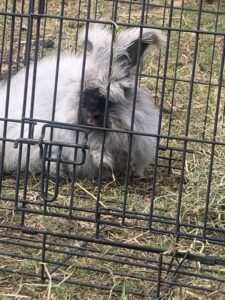
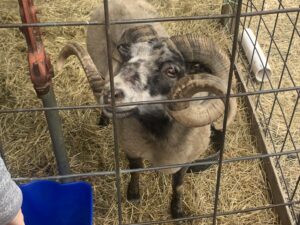

A word on dyes and mordant
Alejandra gave a small talk on the significance of marigolds in indigenous Mexican communities, especially for medicinal uses, as well as for the Day of the Dead celebration. Not only do marigolds have antimicrobial properties: they also were the objects that attracted the souls of dead loved ones to ofrendas, a fact that is partly due to its sweet, floral scent. Similarly, the indigo is a mosquito repellent, so it’s interesting to see how these plants might have been chosen for their physical attractiveness and practical purposes, but likely adopted greater meaning and sanctity over time. Alejandra grew the indigo and marigold herself, but bought the logwood and cochineal (small cactus bugs) elsewhere. The logwood was very expensive: it cost 25$ for just 100g, 50 of which we used to dye a few skeins of yarn. The cochineal bugs were worth their weight in gold.
The mordant (the substance used to bind dyes on fabric) we used (for the marigold and logwood dyes, but not the indigo dyes) was alum, a kind of salt. We used a tablespoon of ground alum per 100g of fibre.



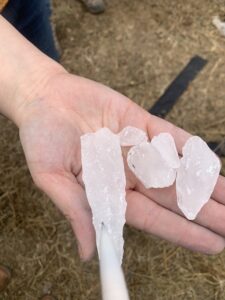


Dyeing
A rough dyeing outline:
- 2:44pm – Started to soak yarn in marigold and logwood dye
- 3:10pm– Dipped pre-wetted yarn in indigo vat. This was only the first of our indigo dyeings of the afternoon.
- 3:40pm – Removed yarn from marigold dye
- 3:45pm – Immersed marigold-dyed yarn in indigo vat
- 3:49pm– Removed yarn from logwood dye
- We had an iron pot of water simmering, and once it boiled we prepared the dyes. The dyes we used were Indigo, Marigold, and Logwood (palo tinto, or literally “tinted wood”). The data recorders got to go inside the big shed to watch the dyes measured out. Meredith told us that preparing different dyes can take vastly disparate amounts of time. The marigold and logwood dyes came from dried crushed plants that were simply steeped in water in a tied sack made of cheesecloth. Indigo was different: it had to be fermented for about a week to make the beautiful blue dye that we used. Once Alejandra finished preparing the indigo, it was added to a vat with lime and fructose.
- After we had steeped our marigolds and logwood in their iron pots of boiling water (which were heated over fire pits using tripods), and prepared our indigo vat, it was time to finally dye the wool. We performed four dyeing processes, each of which with 50g skein of white yarn, and one 50g skein of grey yarn.
- One of the techniques Alejandra had laid out for us was to dye first with marigold, and then with indigo, so naturally there was double the yarn and double the dye in the indigo iron pot (one for the pure yellow wool, another for the indigo wool). Submerging the wool into the boiling pots of logwood and marigold dyes, we left them there for one hour each. The wool we used for marigold and logwood dyes required alum as a mordant.
- For the indigo, we used a “flash-dye” technique, and we got to see the indigo wool oxidize from green to blue right before our eyes as we pulled it out. The indigo wool did not require a mordant. If we would have used one, we would have gotten different colors of wool. First, we pre-wet the fibers before the indigo vat, and then subsequently rung it out a bit, as we didn’t need too much water. Then we slowly submerged the yarn into the dye, so as not to disturb the film on top. As we slowly removed the yarn from the dye, it started as agreen, and then turned blue from oxidation after about 5 seconds.
- After we finished dyeing the actual wool, many of us tried our hands at dyeing various clothing items and body parts. There was a pair of patagonia shorts, a lock of blond hair, a nose, some socks, a forearm and some change. Most of it was from Ben Scott-Lewis, whose child-like joy seemed to be pretty contagious among the class. We also experimented with cochineal makeup: lipstick, eyeshadow, and blush. We felt quite pretty, and the pigment was soft but prominent enough to be seen.

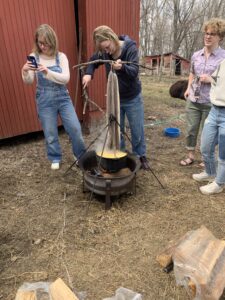
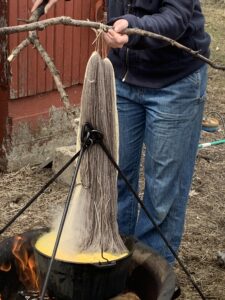
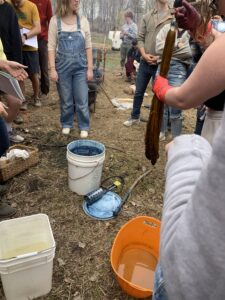

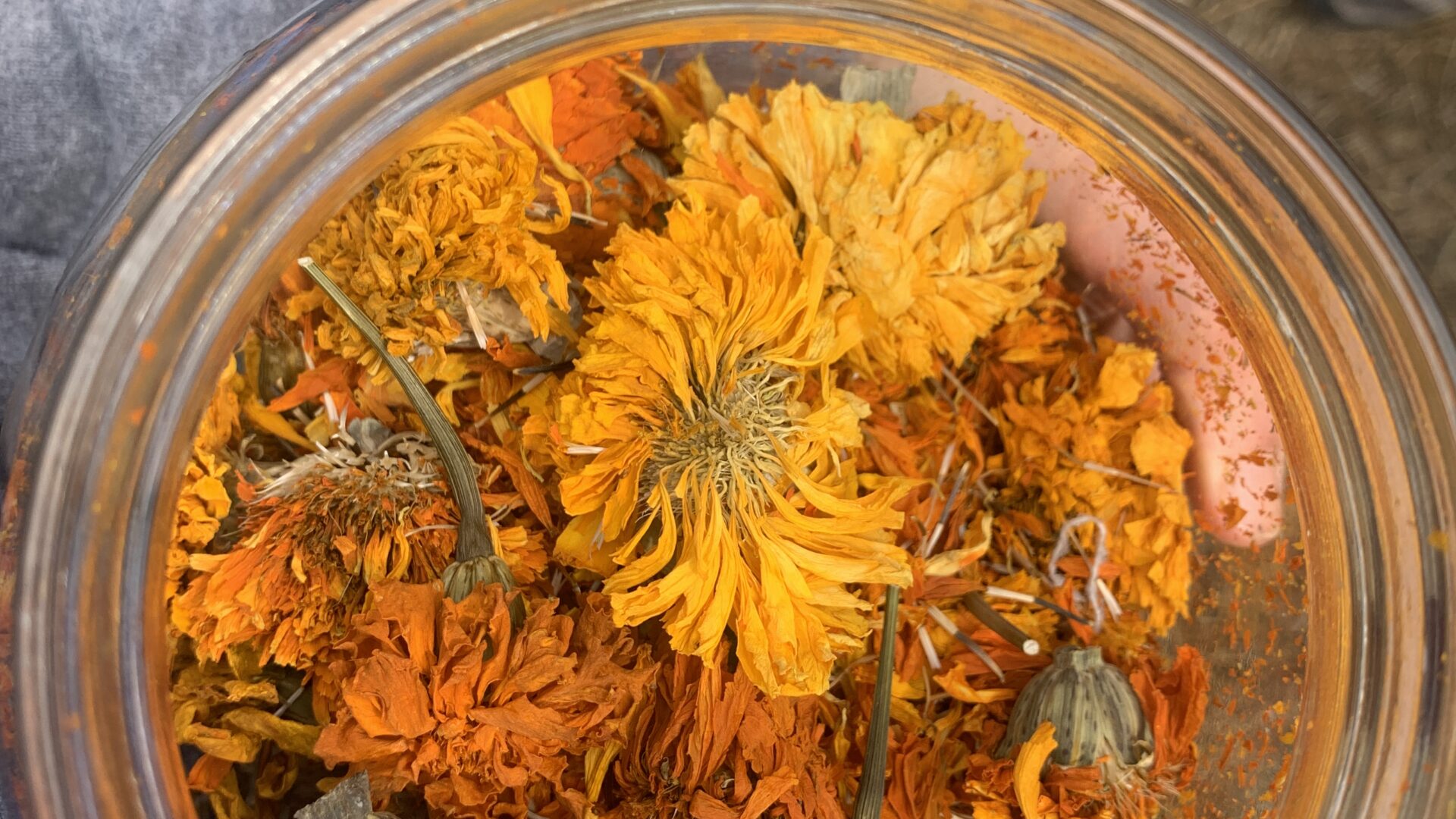
0 thoughts on “Group D: Dyeing”